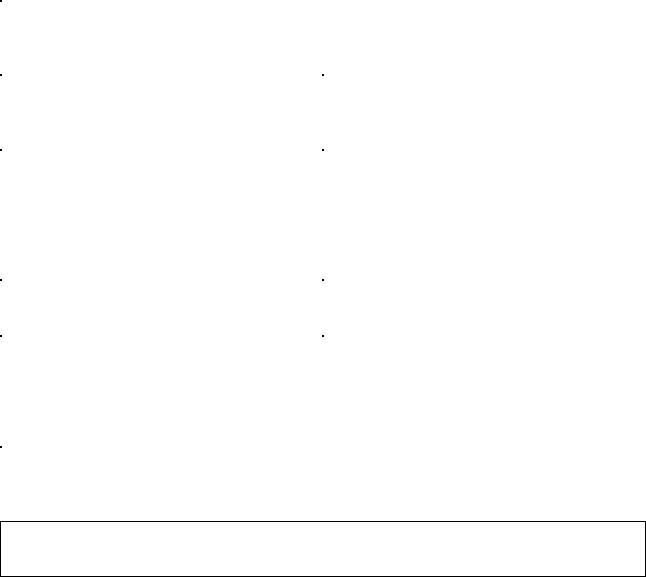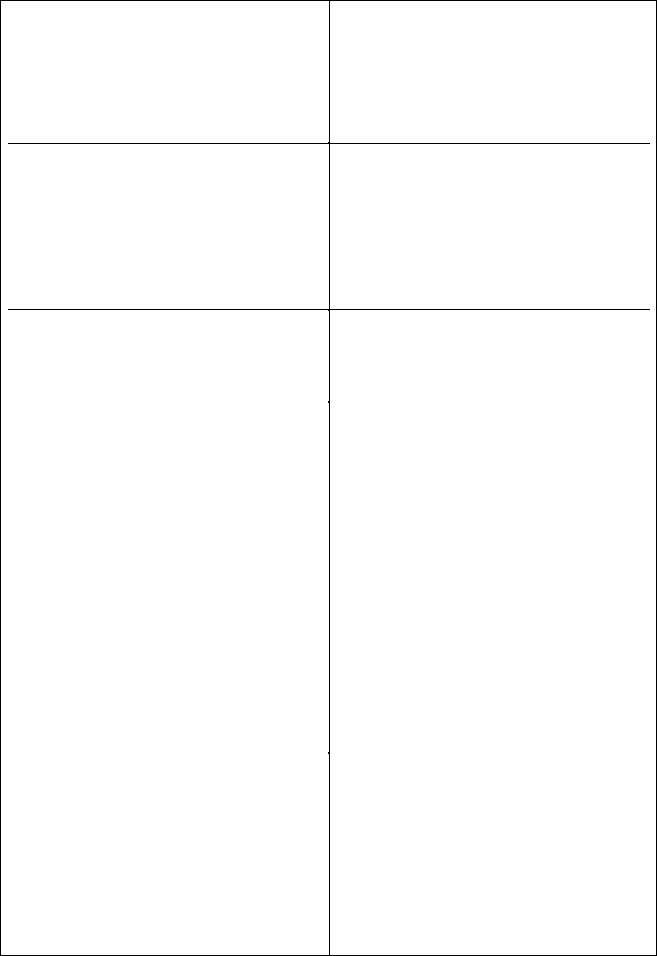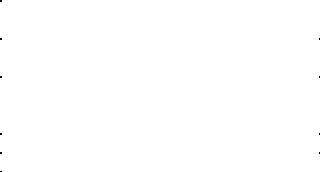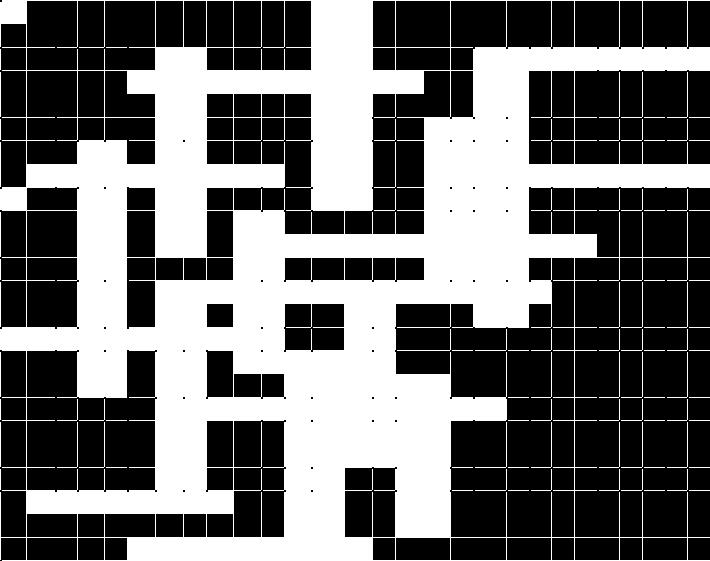
Английскй учебник
.pdf
14. to have different powers and responsibilities |
n. $ & $ & |
|
$ |
15. introduction of the state of emergency and |
o. $ # $ " " |
martial law |
|
7. .
1.The Constitution states that Russia _____________.
2.The Constitution proclaims ______________.
3.The Federation consists of _______________.
4.State power is exercised ________________.
5.The President is ______________.
6.The President’s powers are quite expansive: _________________.
7.The legislature is _____________.
8.The Federation Council consists of ______________.
9.The State Duma consists of ______________.
8. .
Models: It’s true because it conforms to the Constitution.
It’s false because the Constitution states that …..
1.Russia is a democratic and unitary state.
2.The only source of power in the Russian Federation is the President.
3.Civil, political, economic, social, and cultural rights are guaranteed by the state.
4.State power in the Russian Federation is exercised on the basis of its separation by the President, Federal Assembly and the Constitutional court.
5.The President is elected by general election for a term of four years.
6.The Prime Minister is the Head of State.
7.The President dismisses the Government and dissolves the legislature.
8.The President is the head of the Government.
9.The State Duma and the Federal Assembly are two separate chambers of the Federation Council.
10.The State Duma is obligated to examine all bills on budgetary, tax, and other fiscal issues.
11.The Federation Council’s jurisdiction includes the approval of border changes between the constituent components.
12.The State Duma is the lower chamber, and its main duty is to pass laws.
13 Nobody can remove the president from office by impeachment.
14. Nobody can approve the usage of the Armed Forces beyond Russia’s territory.
9. % ! . - #' . -,
!.
1. |
. ( $ |
a. Everyone shall have the right to freedom and |
|
19 |
( 2). |
|
personal immunity. |
2. |
( & " |
&$. ( $ 20 |
b. Everyone shall have the right to the inviola- |
( 2). |
|
bility of private life, personal and family se- |
|
|
|
|
crets, the protection of honour and good name. |
3. |
( & " |
|
c. The right of private property shall be pro- |
$. ( $ 22 (- |
tected by law. |
||
2). |
|
|
|
191

4. ( & " - |
d. Labour is free. Everyone shall have the right |
$ " &, " |
to freely use his labour capabilities, to choose |
", " . |
the type of activity and profession. |
( $ 23 ( 2). |
|
5. ( & |
e. All people shall be equal before the law and |
. ( $ 29 ( 2). |
court. |
6. " |
f. Everyone shall have the right to education. |
. ( $ 35 ( 2). |
|
7. . . ( & " - |
g. Everyone shall be guaranteed the freedom of |
& $ |
literary, artistic, scientific, technical and other |
, $ $ - |
types of creative activity, and teaching. Intel- |
#. ( $ 37 ( 2). |
lectual property shall be protected by law. |
8. ( & " &. + |
|
& $ $ ) & . |
h. Everyone shall have the right to life. |
( $ 40 ( 2). |
|
9. ( & " . |
i. Everyone shall have the right to a home. No |
( $ 43 ( 2). |
one may be arbitrarily deprived of his or her |
|
home. |
10. ( & - |
|
, &, , - |
j. Everyone shall be guaranteed the freedom of |
, - |
ideas and speech. |
. @ $ $ |
|
. ( $ 44 (- |
|
2). |
|
10. ! . -
.
1. judicial protection 2. the right to the consideration 3. the right to qualified legal assistance 4. accused of committing a crime (2) 5. according to the rules fixed by the federal law 6. to prove his innocence 7. in favour of the accused
Everyone shall be guaranteed ( ) of his rights and freedoms. No one may be deprived of ( ) of his or her case in that court and by that judge in whose cognizance the given case is according to law. Everyone shall be guaranteed (# " " ). Any person detained, taken into custody, ( -" ) ), shall have the right to receive assistance of a lawyer (counsel for defence) from the moment of detention, confinement in custody of facing charges accordingly. Everyone ( " ) ) shall be considered innocent until his or her guilt is proved ( # $ ). The accused shall not be obliged ( $ $). Unremoval doubts about the guilt of the person shall be interpreted ( $ ).
11. , & ! & (12-15 ) *-$ % - $ . ( $ +-
.
1.The Constitution of the RF was written …. (follow on with historical reasons).
2.The main features of the Russian Constitution are …
3.The Constitution recognizes a number of individual rights which include …
4.The provisions for protecting these rights are …
5.To sum up …
192
12. . |
|
||
1. |
|
" : - |
|
, , # , $ , & , ", |
, - |
||
, & $ - $ . . |
|
||
2. |
, . |
||
3. |
@, . |
|
|
4. |
+ |
, , # , - |
|
" . |
|
||
5. |
@, $ $ 2 & (- |
||
2 " " , * # , |
& - |
||
$ . |
|
||
6. |
+ |
, - |
|
& , " , -" 2.
7. 2 " " $ $" " . ( , # , & " $.
UNIT 4. THE JUDICIARY IN RUSSIA
1. .
TEXT
THE JUDICIARY IN RUSSIA
The judiciary consists of three independent parts: regionally based federal courts of general jurisdiction, courts of arbitration assigned to the resolution of economic disputes, and the Constitutional Court with the right of judicial review. The institution of justices of peace was introduced for the resolution of small claims at the local level.
Local courts are established in all administrative units of the Russian Federation and function as courts of first instance and courts of appeals for decisions of justices of peace. These courts make initial decisions in the majority of all criminal and civil cases. Federal district courts build the second level of Russia’s judicial system. Their territorial jurisdiction extends to the components of the federation where those courts have been formed. They serve as trial courts in more serious crimes and civil matters, and as appellate courts reviewing local court’s judgments. The Supreme Court is the highest judicial body for civil, administrative, criminal, and other cases within the jurisdiction of courts of general jurisdiction. Justices of the Supreme Court are appointed by the Federation Council. The Court has three divisions: civil, criminal, and military, which hear relevant cases. Thirteen specially appointed justices of the Supreme Court comprise the Presidium of the Supreme Court, the highest judicial instance in Russia in regard to cases heard by way of supervision and for newly discovered circumstances. The plenary session of the Supreme Court may issue explanations on questions pertaining to judicial practice, and it may exercise the Court’s right of legislative initiative by formulating the relevant proposals for their subsequent submission to the Parliament.
193


5.. . .
8.Is Montesquieu’s theory prescriptive or descriptive?
9.Is this theory a practical model of governing a country?
10.What is the essence of this theory?
The constitutional role of the judiciary is based on the theory of the separation of powers which was particularly developed by the French political scientist, Montesquieu. He wrote: “When the legislative and executive powers are united in the same person or in the same body of magistrates, there can be no liberty… Again, there is no liberty, if judiciary power be not separated from the legislative and executive. Were it joined with the legislative, the life and liberty of the subject would be exposed to arbitrary control; for the judge would then be the legislator. Where it joined to the executive, however, the judge might behave with violence and oppression. There would be an end to everything, were the same man, or the same body, whether of the nobles or the people, to exercise those three powers, that of enacting laws, that of executing the public resolutions, and of trying the causes of individuals”. (Montesquieu, De l’Espirit des Lois, 1748).
6. #' .
1. independent 2. legislature (2) 3. United States 4. conform 5. executive (3) 6. judicial 7. three 8. different (2) 9. prescriptive 10. judiciary 11. administrative 12. descriptive 13. legislative
There are (….) main functions of government. These are the (…), the (…), and the (…). The theory of separation of powers states that these functions should be carried out by (…) bodies. The British constitution does not (…) to this theory. The same people are members of the (…) and the (…) and there are some (…) functions which are carried out by the courts. The distinction is clearer in the constitution of the (…) where the executive, legislative and judicial roles are performed by (…) bodies. The theory is (…) rather than (…) of the liberal system of government, an essential feature of which is that the (…) should be (…) of the (…) and the (…).
7. , & ! & (12-15 ) “Separation of Powers”
#' :
1.Define the theory.
2.The reasons for the theory.
3.How the theory is applied to the Russian state system.
4.Comparison of the Russian Constitution with constitutions of other countries.
+ - $ :
However -
Furthermore – (
In addition – ( &
Nevertheless – .
The point is … - > , …
To begin with – &
To sum it up –
196



|
II. |
|
|
|
|
|
|
|
|
|
|
|
|
|
|
|
|
|
|
|
|
|
|
|
|
|
|
|
|
|
|
||
|
|
|
: |
1. |
$; |
|
2. "; |
3. &; |
|
||||||||||||||||||||||||
4. # "; |
5. $ |
( , |
); |
6. $ |
( |
|
&$); |
|
|||||||||||||||||||||||||
7. "; |
8. $ ( $ ); 9. |
( , ) |
|
||||||||||||||||||||||||||||||
; 10. ". |
|
|
|
|
|
|
|
|
|
|
|
|
|
|
|
|
|
|
|
||||||||||||||
|
|
|
: |
1. , |
$; |
2. ); |
3. $; |
|
|||||||||||||||||||||||||
4. " ) ; 5. |
( ); 6. & $ ( &); |
|
|||||||||||||||||||||||||||||||
7. $ |
" ; 8. & |
"; |
9. |
"; 10. $ |
& |
|
|||||||||||||||||||||||||||
$ . |
|
|
|
|
|
|
|
|
|
|
|
|
|
|
|
|
|
|
|
|
|
|
|
|
|
|
|||||||
|
|
|
|
|
|
|
|
|
|
|
|
|
|
|
|
|
|
|
|
|
|
|
|
|
|
|
|
|
|
|
|
|
|
|
|
|
|
|
|
|
|
|
|
|
|
|
|
10 |
|
|
|
|
|
|
|
|
|
|
|
|
|
|
|
|
|
|
|
|
|
|
|
|
|
|
|
|
|
|
|
|
|
|
|
|
|
|
|
|
|
|
|
|
|
|
|
|
|
|
|
|
|
|
|
|
|
|
|
|
|
|
|
|
|
|
|
|
|
|
|
|
|
|
|
|
|
|
|
|
|
|
|
|
|
|
|
|
|
|
|
|
|
8 |
|
|
|
|
|
|
|
|
|
|
|
|
|
|
|
|
1 |
|
|
|
|
|
|
|
|
|
|
|
|
|
|
|
|
|
|
|
|
|
|
|
|
|
|
|
|
|
|
|
|
|
|
|
|
|
|
|
|
|
|
|
|
|
|
|
|
|
9 |
|
|
|
|
|
|
|
|
|
|
|
|
|
|
|
|
|
|
|
|
|
|
|
|
|
|
|
|
|
|
|
|
|
|
|
|
|
|
|
|
|
|
|
|
|
|
|
|
|
|
|
|
|
|
|
|
|
|
|
|
|
|
|
|
|
|
|
|
|
|
|
|
|
|
|
|
|
|
|
|
|
|
|
|
|
|
|
|
|
|
|
|
|
|
|
|
|
|
|
|
|
|
|
|
|
|
|
|
|
|
|
|
|
|
|
|
|
2 |
|
|
|
|
|
|
|
|
|
|
|
|
|
|
|
|
|
|
|
|
|
|
|
|
|
|
|
|
|
|
|
|
|
|
|
|
|
|
|
|
|
|
|
|
|
|
|
|
|
7 |
|
|
|
|
|
|
|
|
|
|
|
|
|
|
|
|
|
|
|
|
|
|
|
|
|
|
|
|
|
|
|
|
|
|
|
|
|
|
|
|
|
|
|
|
|
|
|
|
|
|
|
|
|
|
|
|
|
|
|
|
|
|
|
|
|
8 |
|
|
|
|
|
|
|
|
|
|
|
|
|
|
|
|
|
|
|
|
|
10 |
|
|
|
|
|
|
|
|
|
|
|
|
|
|
|
|
|
|
|
|
|
|
|
|
|
|
|
|
|
|
|
|
|
|
|
|
|
|
|
|
|
|
|
|
|
|
|
|
|
|
|
|
|
|
|
|
|
|
|
|
|
|
|
|
|
|
|
|
|
|
|
|
|
|
|
|
|
|
|
|
|
|
|
|
|
|
|
|
|
3 |
|
|
|
|
|
|
|
|
|
|
|
|
|
|
|
|
|
|
|
|
|
|
|
|
|
|
|
|
|
|
|
|
|
|
|
|
|
|
|
|
|
|
|
|
|
|
|
|
|
|
|
|
|
|
|
|
|
|
|
|
|
|
|
|
|
|
|
2 |
|
|
|
|
|
|
|
|
|
|
|
|
|
|
|
|
|
|
|
|
|
|
|
|
|
|
|
|
|
|
|
|
|
|
|
|
|
|
|
|
|
|
|
|
|
|
|
|
|
|
|
|
|
|
|
|
|
|
|
|
|
|
|
|
|
|
|
|
|
|
|
|
|
|
|
|
|
|
|
|
|
|
|
|
|
|
|
|
|
|
|
|
|
|
|
|
9 |
|
|
3 |
|
|
|
|
|
|
4 |
|
|
|
|
|
|
|
|
|
|
|
|
|
|
|
|
|
|
|
|
|
|
|
|
|
|
|
|
|
|
|
|
|
|
|
|
|
|
|
|
|
|
|
|
|
|
|
|
|
|
|
|
|
|
|
|
|
|
|
|
|
|
|
|
|
|
|
|
|
|
|
|
|
|
|
|
|
|
|
|
|
|
|
|
|
7 |
|
|
|
|
|
|
|
|
|
|
|
|
|
|
|
|
|
|
|
|
|
|
|
|
|
|
|
|
|
|
|
|
|
|
|
|
|
|
|
|
|
|
|
|
|
|
|
|
|
|
|
|
|
|
|
|
|
|
|
|
|
|
|
|
|
|
|
|
|
|
|
|
|
|
|
|
|
|
|
|
5 |
|
|
|
|
|
|
|
|
|
|
|
|
|
|
|
|
|
|
|
|
|
|
|
|
|
|
|
|
|
|
|
|
|
|
|
|
|
|
|
|
|
|
|
|
|
|
|
|
|
|
|
|
|
|
|
|
|
|
|
|
|
|
|
|
|
|
|
|
|
|
|
|
6 |
|
|
|
|
|
|
|
|
|
|
|
|
|
|
|
|
|
|
|
|
|
|
|
|
|
|
|
|
|
|
|
|
|
|
|
|
|
|
|
|
|
|
|
|
|
|
|
|
|
|
|
|
|
|
|
|
|
|
4 |
|
|
|
|
|
|
|
|
|
|
|
|
|
|
|
|
|
|
|
|
|
|
|
|
|
|
|
|
|
|
|
|
|
|
|
|
|
|
|
|
|
|
|
|
|
|
|
|
|
|
|
|
|
|
|
|
|
|
|
|
|
|
|
|
|
|
|
|
|
|
|
|
|
|
|
|
|
|
|
|
|
|
|
|
|
|
|
|
|
|
|
|
|
|
|
|
|
|
|
|
|
|
|
|
|
|
|
|
|
|
|
|
|
|
|
|
|
|
|
|
|
|
|
|
|
|
|
|
|
|
|
|
|
|
|
|
|
|
|
|
|
|
|
|
|
|
|
|
|
|
|
|
|
|
|
|
|
|
|
|
|
5 |
|
|
|
|
|
|
|
|
|
|
|
|
|
|
|
|
|
|
|
|
|
|
|
|
|
|
|
|
|
|
|
|
|
|
|
|
|
|
|
|
|
|
|
|
|
|
|
|
|
|
|
|
|
|
|
|
|
|
|
|
|
|
|
|
|
|
|
|
|
|
|
|
|
|
|
|
|
|
|
|
|
|
|
|
|
|
|
|
|
|
|
|
|
|
|
|
|
|
|
|
|
|
|
|
|
6 |
|
|
|
|
|
|
|
|
|
|
|
|
|
|
|
|
|
|
|
|
|
|
|
|
|
|
|
|
|
|
|
|
|
|
|
|
|
|
|
|
|
|
|
|
|
|
|
|
|
|
|
|
|
|
|
|
|
|
|
|
|
|
10. .
1. ( " 2 " " 2 " " -, , " > , " "" > , $ 2 " " ,2 " " ) ! & 2 " " , -$" $" * 2 " " )( 2 " " . ( $ 125 ( 2)
199
